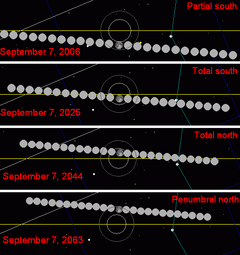

| Partial lunar eclipse 7 September 2006 | |
|---|---|
 From Bucharest, Romania, 18:37 UTC | |
 The Moon's path through the southern edge of the Earth's umbral shadow | |
| Series (and member) | 118 (51 of 74) |
| Gamma | -0.9262 |
| Magnitude | 0.1837 |
| Duration (hr:mn:sc) | |
| Partial | 1:31:06 |
| Penumbral | 4:14:23 |
| Contacts (UTC) | |
| P1 | 16:44:07 |
| U1 | 18:05:47 |
| Greatest | 18:51:19 |
| U4 | 19:36:53 |
| P4 | 20:58:30 |
 The Moon's hourly motion across the Earth's shadow in the constellation of Aquarius | |
A partial lunar eclipse took place on 7 September 2006, the second of two lunar eclipses in 2006. The tables below contain detailed predictions and additional information on the partial lunar eclipse of 7 September 2006.
Penumbral magnitude: +1.13488 (+113.488%)
Umbral magnitude: +0.18568 (+18.568%)
Gamma: -0.92619 (-92.879%)
Greatest eclipse: 2006 Sep 07 at 18:51:20.1 UTC
Ecliptic opposition: 2006 Sep 07 at 18:42:03.3 UTC
Equatorial opposition: 2006 Sep 07 at 18:00:00.9 UTC
Sun's right ascension: 11.080 h
Sun's declination: +5.91°
Sun's diameter: 1904.8 arcseconds
Sun's equatorial horizontal parallax: 17.4 arcseconds
Earth's shadow's right ascension: 23.080 h
Earth's shadow's declination: –5.91°
Moon's right ascension: 23.110 h
Moon's declination: -6.74°
Moon's diameter: 2006.6 arcseconds (6.282% larger than average)
Moon's equatorial horizontal parallax: 7364.6 arcseconds
Moon's longitudinal position: 0.5° West
Moon's latitudinal position: 1.3° North
Moon's libration position: 338.7° (NNW)
Moon's penumbral diameter: 9387.36 arcseconds
Moon's umbral diameter: 5577.84 arcseconds
Northernmost civil twilight/daylight boundary: 83°15'36.9" South, solar midnight
Northernmost nautical twilight/civil twilight boundary: 78°05'36.9" South, solar midnight
Northernmost astronomical twilight/nautical twilight boundary: 72°05'36.9" South, solar midnight
Northernmost nighttime/astronomical Twilight boundary: 66°05'36.9" South, solar midnight
Southernmost latitude to see full darkness for at least 9 hours: 53°43'09.3" South
Southernmost latitude to see full darkness for at least 8 hours: 64°18'04.1" South
Southernmost latitude to see full darkness for at least 7 hours: 69°30'29.1" South
Southernmost latitude to see full darkness for at least 6 hours: 72°35'19.0" South
Southernmost nighttime/astronomical twilight boundary: 77°54'23.1" South, solar midnight
Southernmost astronomical twilight/nautical twilight boundary: 83°54'23.1" South, solar midnight
Southernmost nautical twilight/civil twilight boundary: 89°54'23.1" South, solar midnight
Southernmost civil twilight/daylight boundary: 84°55'36.9" South, Solar noon
| Contact | Date & time (UTC) |
|---|---|
| P1 | 2006 Sep 07 at 16:43:59.5 UTC |
| U1 | 2006 Sep 07 at 18:05:43.2 UTC |
| Greatest | 2006 Sep 07 at 18:51:20.1 UTC |
| U4 | 2006 Sep 07 at 19:37:29.8 UTC |
| P4 | 2006 Sep 07 at 20:59:02.0 UTC |
This is the first eclipse this season.
Second eclipse this season: 22 September 2006 annular solar eclipse
It was completely visible over most of Africa, Europe, Asia and Australia.


A simulated view of the Earth from the center of the Moon at maximum eclipse

Degania A, Israel
| Lunar eclipse series sets from 2006–2009 | ||||||||
|---|---|---|---|---|---|---|---|---|
| Descending node | Ascending node | |||||||
| Saros # and photo |
Date Viewing |
Type Chart |
Gamma | Saros # and photo |
Date Viewing |
Type Chart |
Gamma | |
113
|
2006 Mar 14
|
penumbral
|
1.0211 | 118
|
2006 Sep 7
|
partial
|
−0.9262 | |
123
|
2007 Mar 03
|
total
|
0.3175 | 128
|
2007 Aug 28
|
total
|
−0.2146 | |
133
|
2008 Feb 21
|
total
|
−0.3992 | 138
|
2008 Aug 16
|
partial
|
0.5646 | |
143
|
2009 Feb 09
|
penumbral
|
−1.0640 | 148
|
2009 Aug 06
|
penumbral
|
1.3572 | |
| Last set | 2005 Apr 24 | Last set | 2005 Oct 17 | |||||
| Next set | 2009 Dec 31 | Next set | 2009 Jul 07 | |||||
This eclipse is the first of four Metonic cycle lunar eclipses on the same date, 7 September, each separated by 19 years:
The Metonic cycle repeats nearly exactly every 19 years and represents a Saros cycle plus one lunar year. Because it occurs on the same calendar date, the Earth's shadow will in nearly the same location relative to the background stars.
|
|

|
A lunar eclipse will be preceded and followed by solar eclipses by 9 years and 5.5 days (ahalf saros).[1] This lunar eclipse is related to two partial solar eclipses of Solar Saros 125.
| 2 September 1997 | 13 September 2015 |
|---|---|

|

|
This lunar eclipse-related article is a stub. You can help Wikipedia by expanding it. |